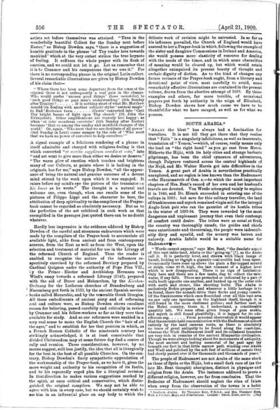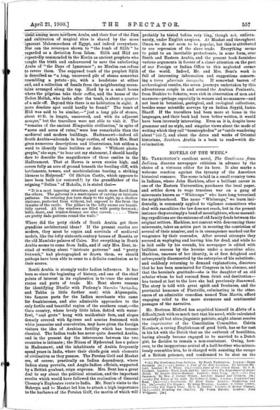SOUTH ARABIA.* " ARABY the blest" has always had a
fascination for travellers. It is not till they get there that they realise that " Felix " is a singularly infelicitous, as well as inaccurate, translation of "Yemen,"—which, of course, really means only the land on "the right hand" as you go east from Mecca. Hitherto the Hijaz, with its holy cities and strange barbaric pilgrimage, has been the chief cynosure of adventurers, though Palgrave ventured across the central highlands of the Nejd, and Mr. Walter Harris got into difficulties in the Yemen. A great part of Arabia is nevertheless practically unexplored, and no region is less known than the Hadramawt —the Hazarmaveth of Gen. x.—to which the most important
chapters of Mrs. Bent's record of her own and her husband's travels are devoted. Von Wrede attempted vainly to explore it in 1846, and Dr. Hirsch succeeded in entering one of the valleys in 1893; but save for this solitary traveller, the land of frankincense and myrrh remained virgin soil for the intrepid Anglo-Irish pair who ran the gauntlet of its hostile tribes in the winter of 1893-94. They were rewarded by the most dangerous and unpleasant journey that even their contempt of comfort could desire. The tribes were as usual at feud, the country was thoroughly unsafe, the guides and chiefs were extortionate and threatening, the people were indescrib- ably dirty and squalid, and the scenery was barren and unlovely. Arabia Infelix would be a suitable name for Hadmm awe- " Words cannot express," says Mrs. Bent, "the desolate aspect of this vast table-land, Akaba or the 'going-up' [s], as the Arabs call it. It is perfectly level, and strewn with black lumps of basalt, looking as though a gigantic coal-scuttle had been upset. Occasionally there rises up above the plain a fiat-topped mound or ridge, some 80 ft. high, the last remnant of a higher level which is now disappearing. There is no sign of habitation. Only here and there are a few tanks, dug to collect the rain- water, if any falls. These are protected or indicated by a pair of walls built opposite one another, and banked up on the outer side with earth and stones, like shooting butts. The Akaba is exclusively Bedou property, and wherever a little herbage is to be found, there the nomads drive their flocks and young camels. Of the frankincense which once flourished over all this vast area we saw only one specimen on the highland itself, though it is still found in the more sheltered gullies ; and farther east, in the Mahri country, there is, I understand, a considerable quantity left. We were often given lumps of gum arabio, and myrrh is still found plentifully ; it is tapped for its odo- riferous sap Prom personal observation it would appear that the ancients held communication with the Hadhramout almost entirely by the land caravan route, as there is absolutely no trace of great antiquity to be found along the coast-line, whereas the Wadi Hadlaramout itself and its collateral branches are very rich in remains of the ancient Himyaritic civilisation. Though we were always looking about for monuments of antiquity, the most ancient and lasting memorial of far past ages lay beneath our feet in that little narrow path winding over Akaba and Wadi and polished by the soft feet of millions of camels that had slowly passed over it for thousands and thousands of years."
The people of Hadramawt are not Arabs of the same stock as those of Syria or the Hijaz, but a small dark race of (as the
late Mr. Bent thought) aborigines, distinct in physique and religion from the Arabs. The .instances adduced to prove a different religion, however, are far from conclusive. That the Bedouins of Hadramawt should neglect the rites of Islam when away from the observation of the towns is a habit
1. Southern Arabia. By Theodore Bent, F.R.G.S., and Mrs. Theodore Bent. With a Portrait, Mao, and Illustrations. London : Smith, Elder, and Co. LISs.3 Eirralng more -no–ritern Arabs, and their fear of the Jinn and cultivation of magical rites is shared by the more - -ignorant Mahommedans of Egypt, and indeed everywhere. Nor can the reverence shown to "the tomb of Salih " be
regarded as a deviation from Islam. Salih and Hild are repeatedly commended in the Koran as ancient prophets who taught the truth and endeavoured to save the unbelieving Arabs of "the Days of Ignorance"; no Muslim can refuse to revere them. The supposed tomb of the prophet Salih is described as "a long, uncovered pile of stones somewhat resembling a potato - pie, with a headstone at either end, and a collection of fossils from the neighbouring moun- tains arranged along the top. Hard by is a small house where the pilgrims take their coffee, and the house of the Bedou Mollah, who looks after the tomb, is about a quarter of a mile off. Beyond this there is no habitation in sight. A more desolate spot could hardly be found." The tomb of Had was said to be similar,—" just a long pile of stones, about 40 ft. in length, uncovered, and with its adjacent mosque," but the travellers were not able to visit it. The "remains of the ancient Himyaritic civilisation," in spite of acres and acres of ruins," were less remarkable than the medireval and modern buildings. Hadramawt—indeed all South Arabia—abounds in huge castles, of which Mrs. Bent gives numerous descriptions and illustrations, but seldom a word to identify their builders or date. "Without photo- graphs," she says, "to bear out my statement, I should hardly dare to describe the magnificence of those castles in the Hadhramout. That at Hawra is seven stories high, and covers fully an acre of ground beneath the beetling cliff, with battlements, towers, and machicolations bearing a striking likeness to Holyrood." Of Shibam Castle, which appears to have been built (or restored ?) by the grandfather of the reigning " Sultan " of Makalla, it is stated that-
" It is a most imposing structure, and much more florid than the others. The gateway is a masterpiece of carving in intricate patterns. On entering you turn sharp to the right, up a shallow staircase, protected from without, but exposed to fire from the inmates of the castle. The pillars in the lofty rooms are beauti- fully carved. All the windows are filled with pretty fretwork ;
bolts, doors, and window-frames are also carved There are pretty dado patterns round the walls."
Where did the petty chiefs of South Arabia get these
grandiose architectural ideas ? If the present castles are mod?rn, they must be copies and survivals of medival
models, like the lofty sixteenth-century houses of Rosetta or the old Mamlake palaces of Cairo. ' But everything in South Arabia seems to come from India, and if only Mrs. Bent, in- stead of writing about "intricate patterns" and "pretty fretwork," had photographed or drawn them, we should perhaps have been able to come to a definite conclusion as to their source.
South Arabia is strongly under Indian influences. It has been so since the beginning of history, and one of the chief points of interest in its exploration is to trace the ancient
routes and ports of trade. Mr. Bent shows reasons for identifying Dhufar with Ptolemy's Maci, 'Ap7if.ac;, and Takha (a little farther east) with Abyssapolie, two famous ports for the Indian merchants who came
for frankincense, and also admirable approaches to the only fertile and beautiful region of the southern coast,—the • Gara country, whose lovely little lakes, dotted with water- fowl, 'cool grots" hung with maidenhair fern, and slopes densely covered with fig-trees and acacias festooned with white jessamine and convolvulus, may have given the foreign visitors the idea of Arabian fertility which has become classical. The Indian trade has never quite deserted Arabia, and in the present day the intercourse between the two countries is intimate ; the Nizam of Hyderabad has a palace in Hadramawt, and the inhabitants of Arabia frequently spend years in India, where their chiefs gain such elements of civilisation as they possess. The Persian Gulf and Maskat are, of course, practically an Indian dependency, where Indian slang prevails, and Anglo-Indian officials, supported by a British gunboat, reign supreme. Mrs. Bent has a great deal to say about the political situation, and the important
results which would have followed the realisation of General Chesney's Euphrates route to India. Mr. Bent's visits to the Bahreyn and to Maskat led him to attach a. high importance
to the harboars of the Persian Gulf, the merits of which will
• probably 'be tested before very icing; though not, unforta- nately,_under English auspices. At Maskat and throughout Oman we do not seem to be popular, but this is attributed to our repression of the slave trade. Everything' seems to point to an inevitable protectorate, in some form, over South and Eastern Arabia, and the present book furnishes various arguments in favour of a closer attention on the part of our Foreign or Indian Office to this neglected corner of the world. Indeed, Mr. and Mrs. Bent's work is full of interesting information and suggestions concern- ing a terra plurintis incognita. If somewhat barren of arcbxological results, the seven journeys undertaken by this adventurous couple in and around the Arabian Peninsula, from Bushire to Sokotra, were rich in observation of men and manners—perhaps especially in women and no-manners—and not least in botanical, geological, and zoological collections, besides some scientific surveys by an Indian Seyyid, Imitm Sharif. If the travellers had been more at home in the languages, and their book bad been better written, it would have been intensely interesting. Even as it is, despite loose grammar and no style, and singular views about the mode of writing which they call' boustrephedon" or "cattle wandering about" (sic I), and about the dates and works of Oriental historians, Southern Arabia is a book to read—with dis- crimination.



































 Previous page
Previous page